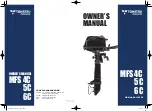
MVME197LEIG/D14-1
4
USING THE 197Bug
DEBUGGER
Entering Debugger Command Lines
197Bug is command-driven and performs its various operations in response to
user commands entered at the keyboard. When the debugger prompt (197-
Bug>
) appears on the terminal screen, then the debugger is ready to accept
commands.
As the command line is entered, it is stored in an internal buffer. Execution
begins only after the carriage return is entered, thus allowing the user to
correct entry errors, if necessary, using the control characters described in the
Debugger General Information chapter in this guide.
When a command is entered, the debugger executes the command and the
prompt reappears. However, if the command entered causes execution of user
target code, for example
GO
, then control may or may not return to the
debugger, depending on what the user program does. For example, if a
breakpoint has been specified, then control returns to the debugger when the
breakpoint is encountered during execution of the user program. Alternately,
the user program could return to the debugger by means of the TRAP #496
function “.RETURN”.
In general, a debugger command is made up of the following parts:
1.
The command identifier (i.e.,
MD
or
md
for the Memory Display
command). Note that either upper- or lowercase is allowed.
2.
A port number if the command is set up to work with more than one port.
3.
At least one intervening space before the first argument.
4.
Any required arguments, as specified by command.
5.
An option field, set off by a semicolon (
;
) to specify conditions other than
the default conditions of the command.
Solution Systems Technologies Inc.
720-565-5995 | [email protected] | www.solusys.com
Solution Systems Technologies Inc.
720-565-5995 | [email protected] | www.solusys.com















































